Veganism & the Environment
By KD Angle-Traegner / Last Update: October 2020
Our environment is in serious trouble.
We are in the midst of terrible ecological devastation.
Raising animals for food is the single greatest human-caused source of destruction to our environment.
It’s the largest source of greenhouse gases and land use; the number one source of water pollution and rainforest deforestation.
Plus, it’s a significant contributor to air pollution, ocean dead zones, habitat loss, and species extinction.
And when we include all the additional resources that go into raising animals for food – the land, fertilizers, pesticides and insecticides, fossil fuels, freshwater, and food – animal agribusiness is shockingly inefficient. Moreover, it’s a costly and wasteful use of our very limited natural resources.
Veganism is the solution.
QUICK NAVIGATION
QUICK FACTS
CATEGORY
Living
MIN TO READ
30
INFOGRAPHICS
1
Veganism & the Environment
By KD Angle-Traegner / Last Update: October 2020
Our environment is in serious trouble.
We are in the midst of terrible ecological devastation.
Raising animals for food is the single greatest human-caused source of destruction to our environment.
It’s the largest source of greenhouse gases and land use; the number one source of water pollution and rainforest deforestation.
Plus, it’s a significant contributor to air pollution, ocean dead zones, habitat loss, and species extinction.
And when we include all the additional resources that go into raising animals for food – the land, fertilizers, pesticides and insecticides, fossil fuels, freshwater, and food – animal agribusiness is shockingly inefficient. Moreover, it’s a costly and wasteful use of our very limited natural resources.
Veganism is the solution.
QUICK NAVIGATION
QUICK FACTS
CATEGORY
Living
MIN TO READ
30
INFOGRAPHICS
1
Resource Depletion
A diet and lifestyle that include animal products don’t just come at a high price to the animals; they also come at a high price to our environment too.
From the air to the land to the water, the resources of the world are being exploited to fuel animal agribusiness with absolutely catastrophic results.
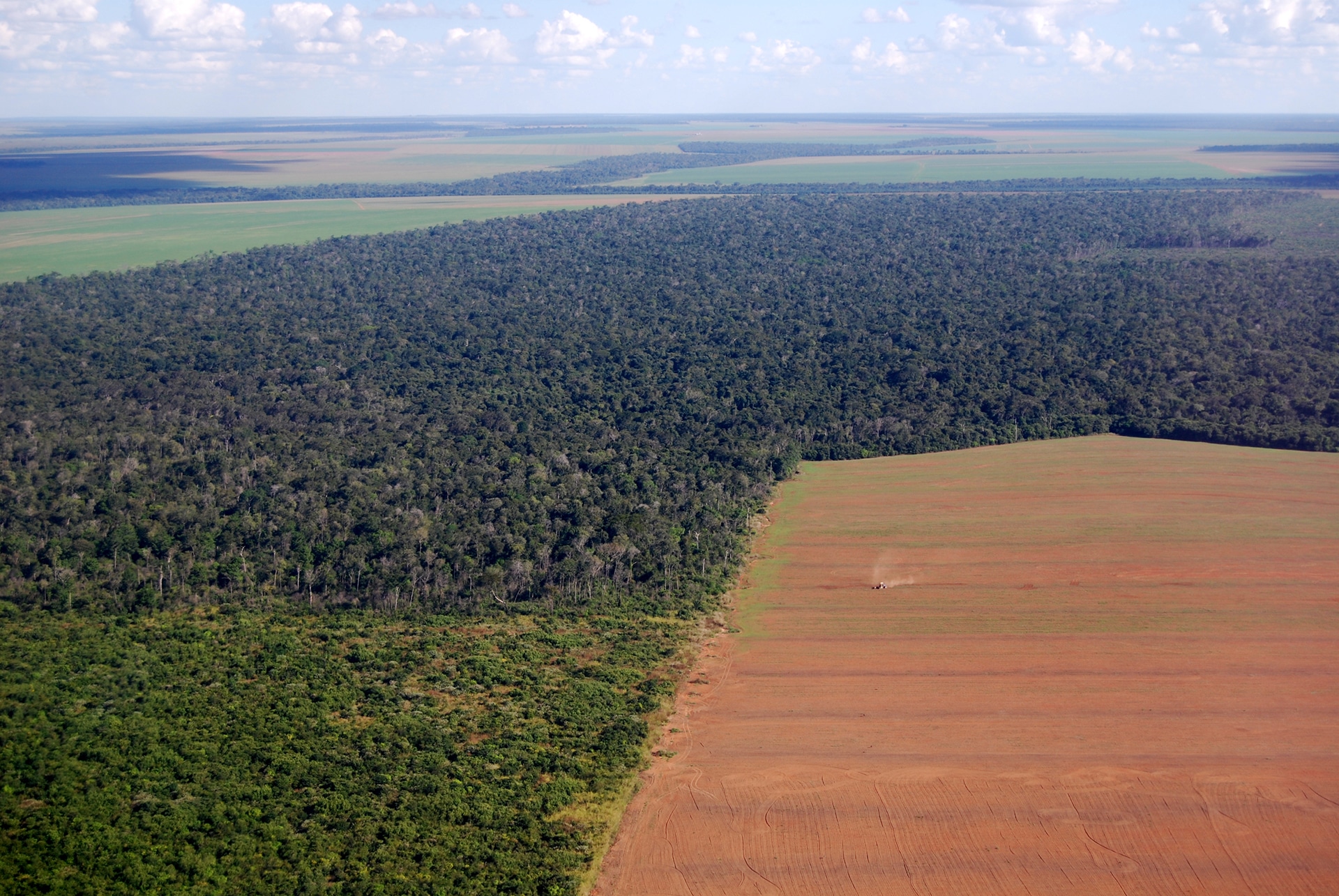
The Land
Raising animals for food requires enormous, massive amounts of land. It uses 45% of Earth’s total land (1) and is responsible for a whopping 91% of all Amazon destruction, with one to two acres of rainforest cleared every second. (2) Those numbers are significant because the rainforest is a vital part of the world’s ecosystems.
The Amazon Rainforest covers more than a billion acres, encompassing areas in Brazil, Venezuela, Colombia, Ecuador, and Peru. It’s so large if Amazonia were a country it would be the ninth largest one in the world.
Commonly called the “Lungs of our planet,” the rainforest provides twenty percent of the world’s oxygen, approximately 10% of the world’s biodiversity, and 15% of its freshwater. (3)
Deforestation is threatening the existence of the Amazon Rainforest
Of all Amazonia, Brazil has the most significant percentage of the rainforest.
Satellite-based research has found that 277,607 square miles – 17.5 percent of Brazil – had been cleared by 2008, with 62 percent of the area deforested now occupied by cattle pasture. (4) Now the largest exporter in the world, Brazil supplies nearly one-quarter of the global beef market. (5)
Pasture land outweighs planted cropland by five times. (6)
“For each hamburger that originated from animals raised on rainforest land, approximately 55 square feet of forest have been destroyed. (7)
After Brazil, Peru has the next largest expanse of the Amazon; nearly half is forested.
The highest concentration of deforestation is in the Huanuco region. Here again, cattle ranching is the main culprit. Satellite images of the deforested area taken during 2013-2015 revealed Hunanuco lost nearly 20,000 acres of rainforest during those years. (8)
As a comparison; one acre is roughly the size of a football field.
And it’s not just the rainforest. Here in the United States, more than 260 million acres of forest have been clear-cut for animal agribusiness.
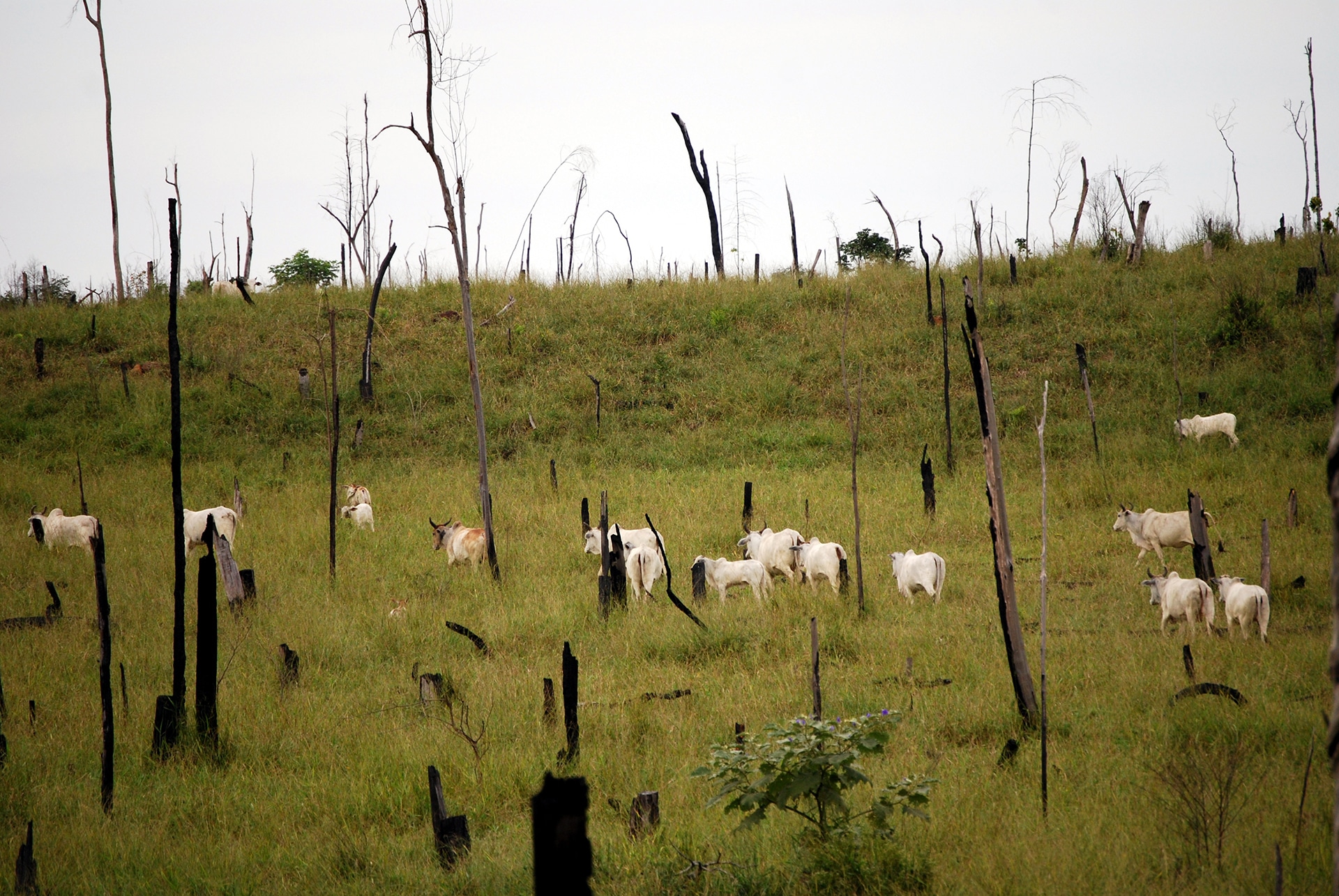
Why Does Deforestation Matter?
Deforestation matters because trees play a critical role in mitigating climate change.
Removing trees deprives forests portions of its canopy, which cause multitudes of environmental problems.
Trees help perpetuate the water cycle by absorbing rainfall and returning water vapor to the atmosphere; which they can’t do if they don’t exist. Without protection from the sun-blocking tree cover, forest soil drys out and former forest lands become barren deserts (because there are no trees to return water vapor to the atmosphere).
The canopy also regulates temperature (blocking the sun’s rays during the day and holding in the heat during the night) and disruptions can cause extreme temperature swings. (9)
Carbon Sinks
Of all the roles trees play in climate change, their role as carbon sinks might be the most important.
A carbon sink is anything in nature that holds or stores more carbon that it releases. Like trees. They manage this by acting like a sponge and soaking up carbon and other greenhouse gases that would otherwise be free and wrecking havoc on climate patterns.
Then, using photosynthesis, trees convert the stored carbon dioxide (CO2) into sugar, cellulose, and other carbon-containing carbohydrates that they then use for food and growth. (10) Forests (particularly vast tropical forests like the rainforest) can store enormous amounts of carbon.
Unless the forest is deforested. Then, not only are the trees gone causing habitat loss and all sorts of environmental chaos, but all the stored carbon is released back into the atmosphere too.
Deforestation releases nearly a billion tons of carbon into the atmosphere every year. (11)
Clearing the world’s forests would release more than three trillion tons of carbon dioxide, more than the amount of the global reserves of oil, coal, and gas. (12)
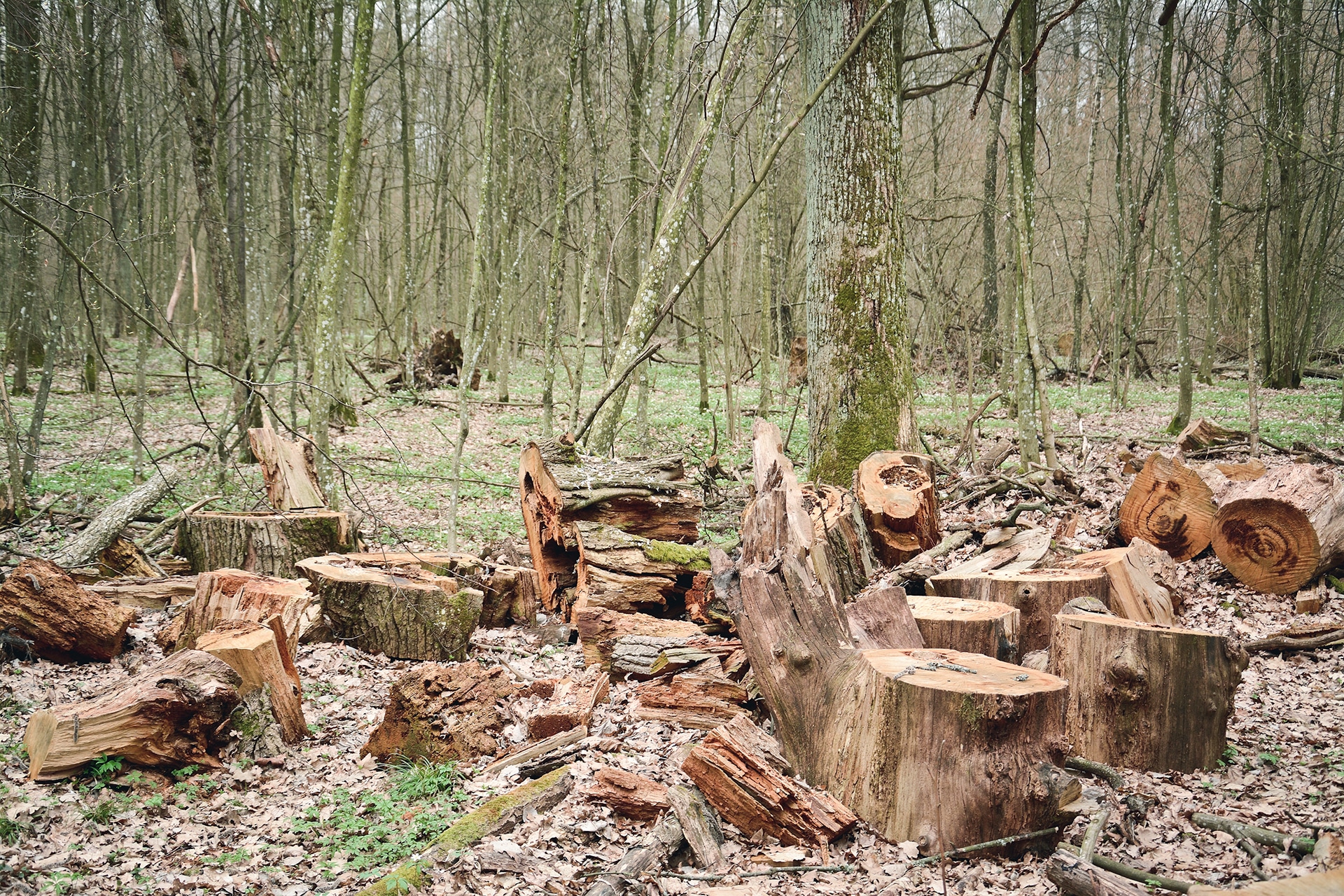
Other Effects of Deforestation
Forests are diverse, complex ecosystems that affect nearly every species on the planet. When degraded, it can set off a disastrous chain of events locally as well as globally.
- Habitat Loss & Species Extinction: Eighty percent of land animals live in forests and are losing their homes to deforestation. (13) Loss of habitat leads to species extinction, gradually dying over several generations.
- Soil Erosion: Tree roots anchor soil. Without them, the dirt can wash or blow away. This leads to vegetation growth problems. After clearing forest, crops like coffee, soy, and palm oil are planted which have no root strength to hold onto the soil. The more extreme the soil erosion is, the more extreme the flooding and landslide issues will be.
- Water Quality: Speaking of soil erosion, it can lead to silt entering water sources like lakes and streams. This addition of sediment to the freshwater decreases overall water quality and contributes to poor health for people in the affected areas.
- Quality of Life & Livelihood: Many native tribes live in the rainforests of the world. There are over 350 indigenous communities that depend on the rainforest throughout Amazonia alone. (14) Destroying these forests also destroys the homes and way of life for them.
The Amazon Tipping Point
Animal-based food production causes great harm to the Amazon Rainforest.
Without action, its impact will get far worse as the world population rises and more people eat meat-rich diets.
“We know food choices are very personal, and that behaviour change can be difficult to encourage, but the evidence is now unequivocal – we need to change our diets if we are to have a sustainable future. The fact that it will also make us healthier makes it a no-brainer.” – Professor Peter Smith at the University of Aberdeen (15)
How much deforestation could occur before the rainforest’s natural water cycle would stop supporting its ecosystem?
The answer is shocking: there isn’t much time before 50 percent of the Amazon Rainforest becomes a degraded savannah. Deforestation in the Amazon over the past 50 years has impacted nearly 17 percent of its vegetation.
If the remaining three percent are wiped out, the rainforest will become unsalvagable. (16)
Science & Research
The science and research done on the environmental impacts of animal agriculture is always growing. Here are a few articles and academic papers to note for further exploration and additional information:
- 2018 – This research article covers the most comprehensive analysis to date and combines data from every country to assess the food system’s impact on the environment. Considerable reductions in meat-eating are essential to avoid catastrophe. In western countries alone, beef consumption needs to fall by 90 percent and replaced with five times more beans and legumes. Continue to the full article >> Options for Keeping the Food System Within Environmental Limits
- 2017 – Researchers have found that stopping deforestation, restoring forests, and improving forestry practices could reduce 42% of total emissions calling it a “natural climate solution.” Continue to the full article >> Conserving Forests Could Cut Carbon Emissions As Much As Getting Rid of Every Car on Earth
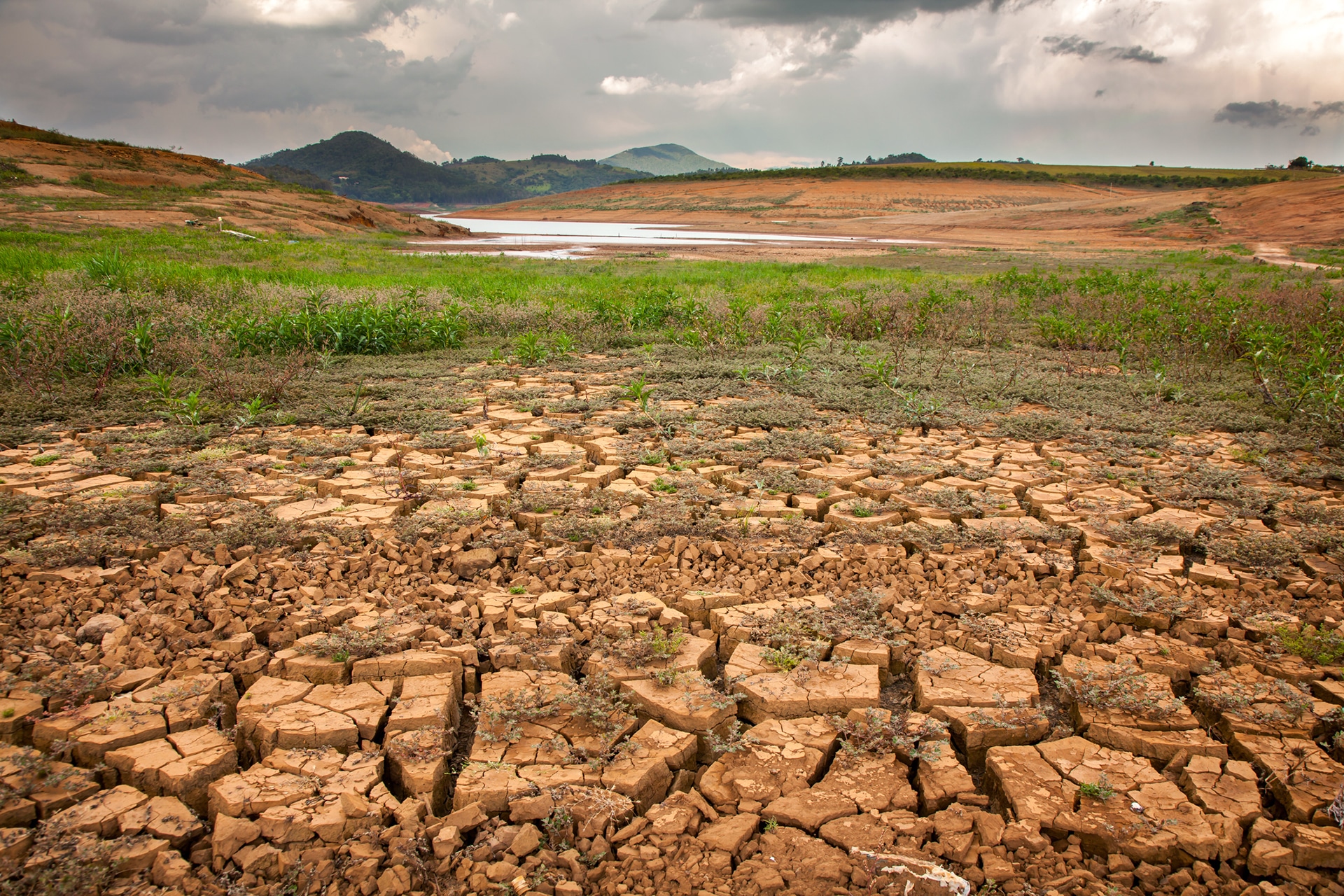
The Water
Water scarcity is the lack of sufficient available water resources to meet the demands of water usage, and it affects every continent.
More than 1.2 billion people — almost one-fifth of the world’s population — lack access to clean drinking water. Another 500 million people are approaching the same situation. (17)
Shamefully, much of the fresh water available for global consumption finds itself used for animal agribusiness. The amount of resources it takes to produce animal products is just astonishing.
Here are some fast facts:
- Animal agribusiness is responsible for 80-90% of water consumption, more than any other activity in the United States. (18)
- They’re also responsible for 20 – 30 percent of all freshwater use in the world. (19)
- Growing feed crops for livestock consumes 56 percent of the water. (20)
- In the US, five percent of water consumed is by private homes whereas animal agribusiness consumes 55 percent. (21)
- Producing one pound of beef requires 2,500 gallons of water. (21)
- One pound of eggs requires 477 gallons of water. (21)
- One gallon of milk needs roughly 1,000 gallons of water. (21)
Water Pollution
Global production of animal products is rapidly increasing.
Soaring demand puts pressure on the environment, particularly on water quality. There’s more solid and liquid manure from livestock — more than 85 percent of the world’s poop is from chicken, cattle, sheep, and pigs (23) — more nutrients, feed additives, hormones, antibiotics, heavy metals, agrochemicals, and sediments that flow into waterways as a result of expanding production of livestock and animal feed.
Here in the U.S., fecal waste from factory farms contaminated groundwater in seventeen states and polluted more than 35,000 miles of rivers in twenty-two. (24)
Dead Zones
Widespread use of pesticides, herbicides, and chemical fertilizers in the production of feed crops poison waterways, creating dead zones in the oceans. (25)
Dead zones are areas in large bodies of water — typically in the sea but occasionally in lakes and even in rivers — that don’t have enough oxygen in the water to support life.
The cause of dead zones is usually eutrophication, an increase in chemical nutrients in the water. Excess nutrients can stimulate an overgrowth of algae, which then sinks and decomposes in the water. It’s the decomposition process that consumes the oxygen and depletes the underwater supply for other marine life. (26)
While they do occur around the world, dead zones primarily occur near areas where heavy agricultural and industrial activity spills nutrients into the water and compromises its quality.
There are now more than 500 nitrogen flooded dead zones around the world as a result of livestock operations. (27) The largest human-caused dead zone in the global ocean is in the Gulf of Mexico along the Louisiana and Texas coast. It measures a whopping 8,776 square miles, as large as the state of New Jersey. (28)
Science & Research
The science and research done on the impact animal agriculture has on water is always growing. Here are a few articles and academic papers to note for further exploration and additional information:
- 2018 – Industrial agriculture is one of the leading causes of water pollution, where it has overtaken contamination from settlements and industries as the major factor in the degradation of both inland and coastal water. Here in the U.S., agriculture is the main source of pollution in rivers and streams, the second source of pollution in wetlands, and the third main source in lakes. Continue to the full article >> More People, More Food, Worse Water? A Global Review of Water Pollution from Agriculture
- 2018 – Three-quarters of large U.S. meat processing plants discharge their wastewater directly into streams and rivers, violating pollution control permits and dumping as much nitrogen pollution as small cities. The largest polluter, a slaughterhouse in Illinois, releases 1,850 pounds of nitrogen on average every day into a tributary of the Illinois River. Between 2005 and 2014, pollution from hog farm operations there killed at least 492,000 fish. Continue to the full article >> Water Pollution from Slaughterhouses

Section Summary:
Is Eating Meat Bad for the Environment?
There’s no way around it: a diet and lifestyle that include animal products cause harm to the environment. From the air to the land to the water, the natural resources of the world are being exploited to fuel animal agribusiness with catastrophic results.
Habitat Loss & Species Extinction
Tragically, nearly every action we take as humans contribute to habitat loss and displace animals.
From urban sprawling shopping centers to cutting down trees in yards, animals and their families are continually forced out of their natural homes, disrupting what remains of an already fragile ecosystem.
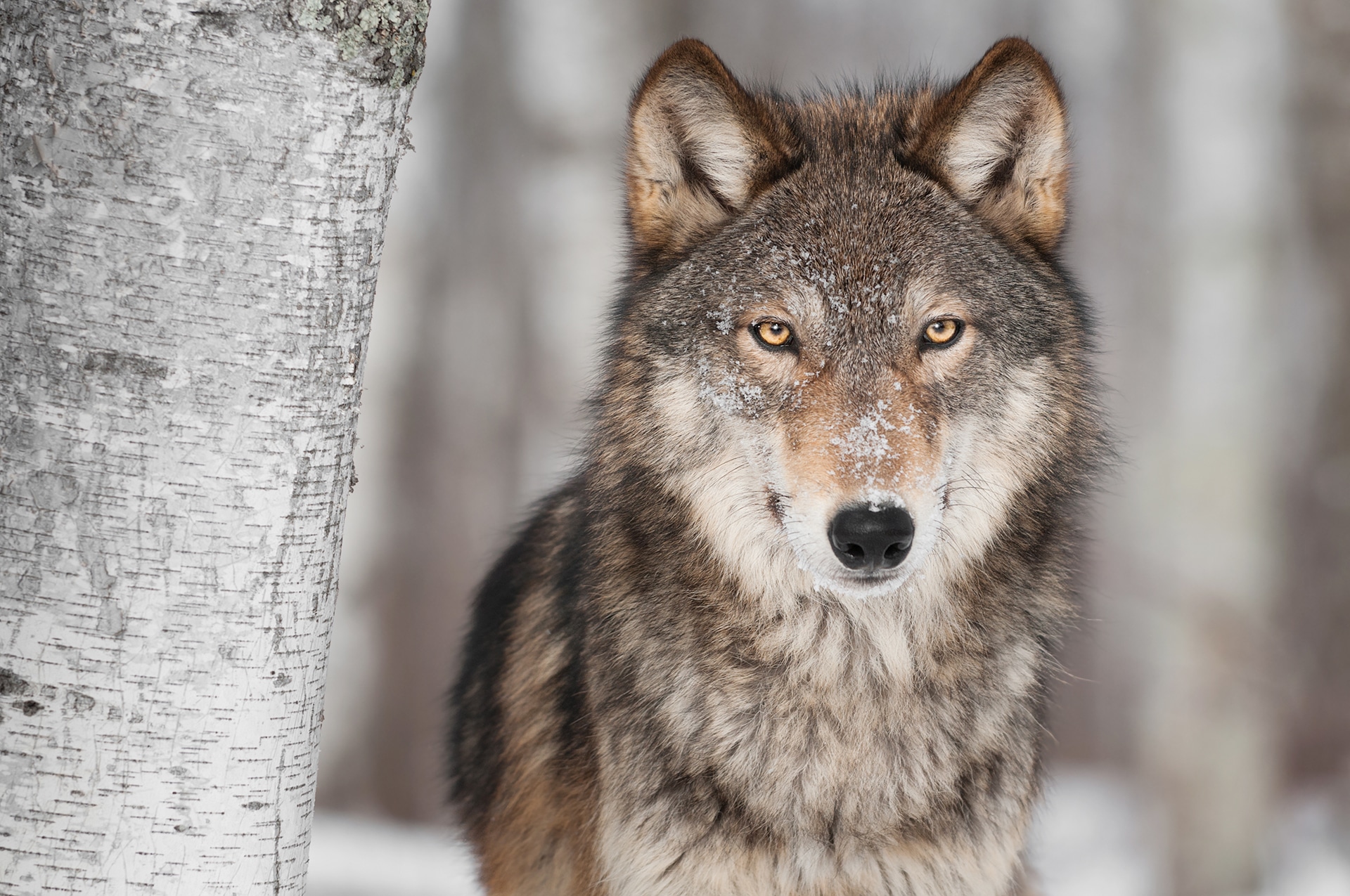
Habitat Loss
Animal agribusiness not only depletes natural resources at an alarming pace, but it also contributes to habitat loss. It does this through deforestation and the poisoning of waterways.
There’s a monumental amount of habitat destruction as a result of deforestation.
Forests are teeming with a vast diversity of life; eight of ten species found on land live in them. Trees outside of woods — like the ones in residential neighborhoods for example — are also home to many animals. Little thought is given to where all these animals will go when the trees are cut down, or if they and their families will even survive.
Many don’t.
In addition to clearing forests and converting land to grow feed crops for grazing pastures, the pesticides, herbicides, and fertilizers used in feed crops poison waterways, rendering them also uninhabitable.
Finally, and perhaps more insidiously, is the relationship between animal agribusiness and the United States Department of Agriculture (USDA) Animal and Plant Health Inspection Service (APHIS) Wildlife Services (WS).
Animals don’t only lose their homes; they can also lose their lives.
USDA APHIS Wildlife Services (WS)
Who is the USDA APHIS Wildlife Services (WS)?
According to their website, they are a branch of the U.S. government established in 1931 to “provide Federal leadership and expertise to resolve wildlife conflicts to allow people and wildlife to coexist.” By, resolving “wildlife damage to a wide variety of resources.” (Whatever that means.)
What’s their connection to animal agribusiness?
In a nutshell, Wildlife Services kills predators and free-living animals deemed competition for the land because of the perceived threat to livestock. More than thirty million free-living animals – many endangered – have been killed by them.
Each year, Wildlife Services spends millions of tax-payer dollars killing native carnivores and predators of farmed animals like coyotes, wolves, bears, mountain lions, and many others. Methods of removal include gassing, being torn apart by trained dogs, strangled in neck snares or leg-hold traps, and gunned down from helicopters.
“Collateral Damage”
“It makes no sense to spend tens of millions of dollars to kill predators, especially in the way that it’s done, to the extent that it’s done, when it can have cascading effects through the ecosystem, unintended consequences, and nontarget consequences.” – Bradley Bergstrom, Professor of wildlife biology at Valdosta State University and chairman of the American Society of Mammalogists conservation committee (29)
Together with the outright removal and killing of competitor free-living animals, Wildlife Services also kills tens of thousands of “non-target’ animals each year.
Collateral victims include a menagerie of more than 300 species like the federally-protected Golden and Bald eagles, beavers, armadillos, badgers, great-horned owls, skunks, antelope, porcupines, ducks, turtles, vultures, weasels, red tail hawks, black bears, cranes, foxes, and river otters, to name a few.

Species Extinction
Earth is in the middle of the sixth mass extinction (30), caused primarily by animal agribusiness.
The impact on land use is “likely the leading cause of modern species extinctions,” and it’s a problem that researchers think will only get worse. (31)
Humans have wiped out 60 percent of mammals, birds, fish, and reptiles since 1970, and the annihilation of wildlife is now an emergency that threatens all of civilization. (32) The estimate produced by 59 scientists from across the globe warn that the consumption of resources is destroying the web of life, something that took billions of years to create.
“We are sleepwalking towards the edge of a cliff. If there was a 60% decline in the human population, that would be equivalent to emptying North America, South America, Africa, Europe, China, and Oceania. That is the scale of what we have done. This is far more than just being about losing the wonders of nature, desperately sad though that is, this is actually now jeopardizing the future of people. Nature is not a ‘nice to have’ – it is our life-support system.” – Mike Barrett, executive director of science and conservation at World Wildlife Fund (33)
Science & Research
The science and research is always growing, but researchers continually come to the same conclusion: raising animals for food is the number one cause of species extinction.
- 2018 – The biomass of humans and livestock — dominated by cattle and pigs — far surpass that of wild mammals. While the total biomass of wild animals decreased, the total mass of mammals increased approximately fourfold from the vast increase in the biomass of humanity and its associated livestock. Continue to the full article >> The biomass distribution on Earth
- 2017 – Academics warn that the rapid rate of species loss could ultimately result in the sixth mass extinction of life saying, “We’re losing species we have never heard of, those we’ve yet to put a name to and industrial agriculture is very much at the spear-tip of that.” They want to declare a new age of Earth: the Anthropocene, since “the fossils of soon-to-be-extinct animals will form a line in the rocks of the future.” Continue to the full article >> Industrial Farming is Causing the Sixth Mass Extinction on Earth, says leading academic
- 2016 – Research shows that overexploitation and agricultural activity are the “most prevalent threats facing 8,688 threatened or near-threatened species at rates” and that “cannot be compensated for by reproduction or regrowth.” Continue to the full article >> Biodiversity: The ravages of guns, nets, and bulldozers
- 2015 – According to researchers, “Livestock production is the single largest driver of habitat loss” and recommend a shift to plant-based foods as “90% of food consumed.” Continue to the full article >> Biodiversity conservation: The key is reducing meat consumption.
Further Reading
- “The meat industry is a subject loaded with a moral and ethical charge. But when I think of these pictures, I don’t just see gigantic farms, I see an attitude toward life and death that exists throughout contemporary culture. These images reflect a blueprint and a horror that lie at the heart of the way we live.” – Mishka Henner: Feedlots
Section Summary:
How does animal agriculture cause species to go extinct?
Species extinction happens because converting previously unfarmed land for animal agriculture via deforestation — both for grazing and growing their food — destroys huge amounts of habitat. Equally important, the waterways are full of wastewater, rendering them also inhabitable. Not to mention, competitor animals are routinely killed by groups like Wildlife Services.
The Humane Myth
There’s an idea propagated by industries who make money using animals, and, sadly, some animal welfare organizations, that it’s possible to farm animals in a kind, compassionate way.
This idea is called The Humane Myth.
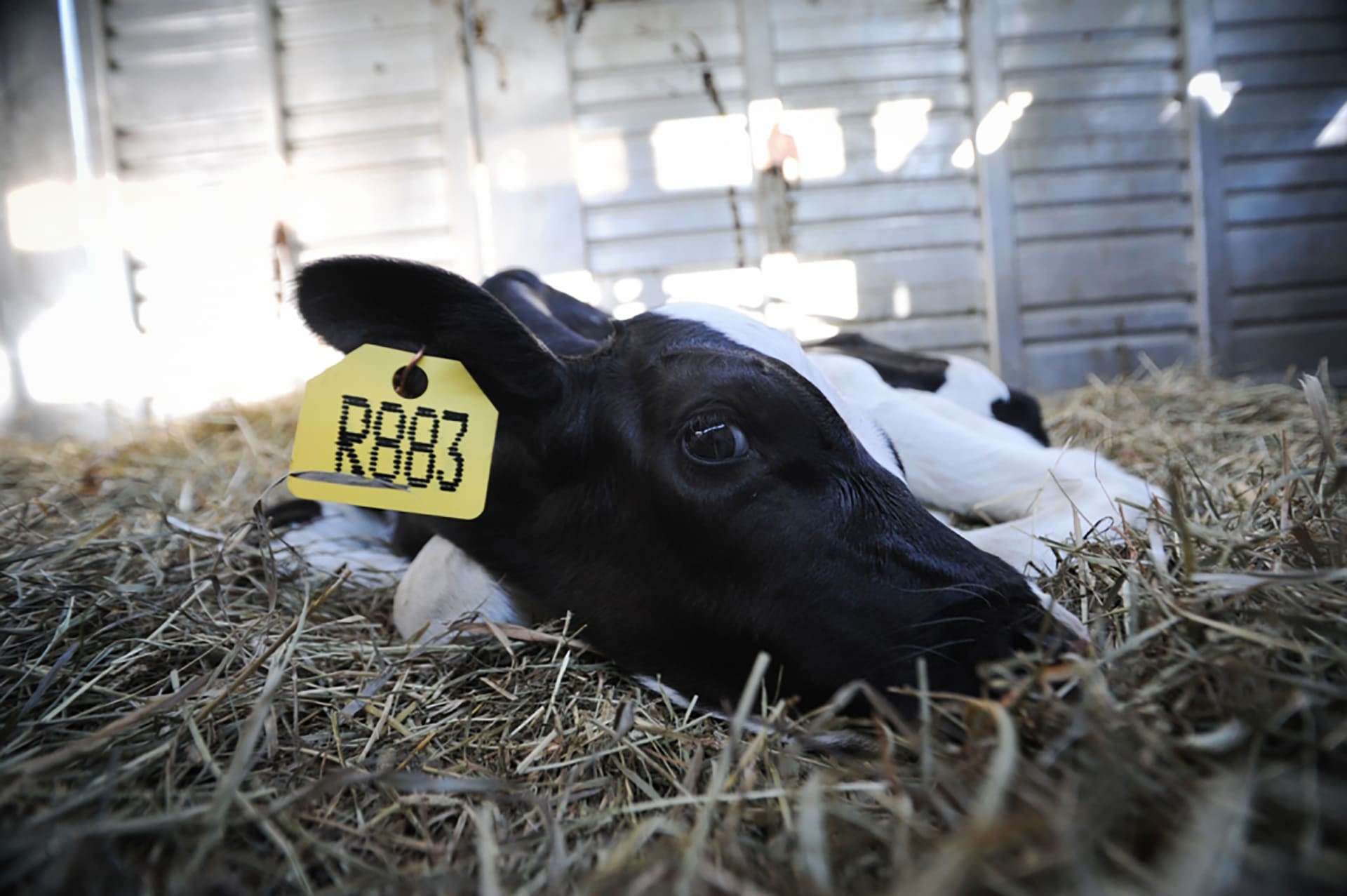
Sonny rescued by Farm Sanctuary. New York, USA. (Photo: JoAnne McArthur / weanimals.org)
The Myth of “Humane” Farming
You’ve seen them popping up in advertisements and on meat packages at the store; labels with words like “Cage-free,” “Free-Range,” or “Humane-Certified.” These labels are meant to sell the idea of “humane” farming by evoking compassion in consumers to make them feel better about purchasing animal products.
Here’s the humane myth these labels are selling: Some ranchers and farmers treat their animals with care, implementing the best livestock husbandry practices that protect animals’ health and well-being. They raise animals on pasture land, allowing them to move freely and engage in select instinctive behaviors, consume a natural diet, and avoid the stress and illness associated with confinement and factory farming. Then, they’re sent to slaughter to be “humanely” killed.
Though, the label is less specific about that.
The Smoke and Mirrors of “Humane” Farming
“Many organizations spend their time-fighting sprawl and championing agriculture a benign use of the land. If a similar amount of effort were directed toward reducing agricultural production, we would produce far greater protection and restoration for declining species, endangered ecosystems, and ecological processes.” (34)
Setting any ethical, environmental, or health-related arguments about “humane” farming aside, it just isn’t doable on a practical level. Confinement factory farming methods dominate global animal agriculture. Even so, farm animals still use 45% of the Earth’s entire land surface. (1) The United States has 2.3 billion acres of land. However, the 375 million acres in Alaska are unsuitable for agricultural production. Subtract that, and it leaves roughly 1.9 billion acres in the lower 48 states. (34)
Let’s say we pasture feed all of the 103 million cows (35) in the United States as “humane” farming advocates suggest. Grass-grazing requires 2 to 20 acres of land per cow. If we raised all the cows on grass (all 103 million of them) cattle would need (using an estimate of ten acres per cow) a tremendous amount of land. And that’s not counting the space required for pastured chicken, pigs, and other farmed animals.
Nothing about this is sustainable; we don’t have enough resources for an agricultural system of that size.
Further Reading
Section Summary:
Isn’t it better to buy “humane” animal products?
Presently, over 50 billion animals are killed annually worldwide. That’s a big number. Resource-wise, it’s impossible to meet the needs of each. Ethically speaking, one cannot kill someone who does not want to die and call it humane. So, yes, it’s important to care about how the animals are treated. Don’t let the labels dupe you, the best way to do that is by rejecting animal products (which reduces demand) and living vegan.
Climate Change
Science: It’s real, not opinion.
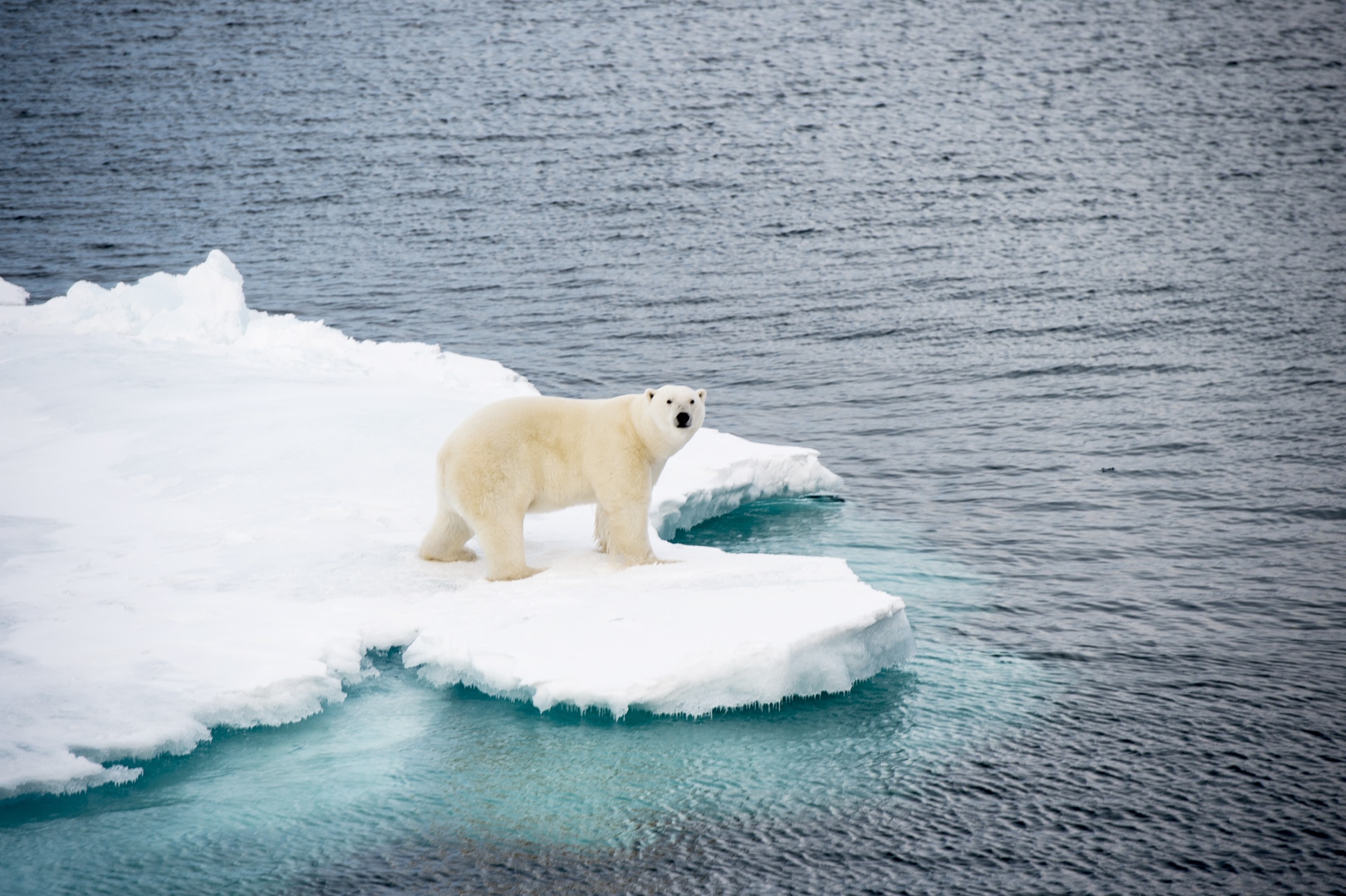
Animal Agribusiness Drives Climate Change
In a landmark UN report, the world’s leading scientists warned that there are just twelve years to keep global warming under 1.5 celsius or we significantly worsen the risks of drought, floods, and other extreme temperature changes. (36)
Twelve. Years.
That timeline is shocking. Generally speaking, conversations about climate change usually end up including fossil fuels. Mentioned far less are the ways that animal agriculture contributes to the changing climate.
There are several:
- Fossil Fuels – It takes more than 11 times more fossil fuels to produce a single calorie from animal-based protein as it does to produce one calorie from plant-based protein. (37)
- Deforestation – Of all the roles trees play in climate change, their role as carbon sinks might be the most important. A carbon sink is anything in nature that holds or stores more carbon that it releases. Like trees. They manage this by acting like a sponge and soaking up carbon and other greenhouse gases that would otherwise be free and wrecking havoc on climate patterns. See also: Deforestation
- Air Pollution – Raising animals for food, along with the food to feed those animals, is a significant source of air pollution. Air pollutants contribute to climate change by affecting the amount of sunlight that is reflected or absorbed. Some pollutants warm the Earth while others cool it. (38) Agricultural emissions affect both local and regional environmental quality, including odor and particulate matter (PM). Animal agriculture also contributes to the global problems caused by greenhouse gas emissions.
Agricultural Air Pollution
Animal agriculture might be the last thing you think about when imagining air polluting industries, perhaps that’s because air emissions from raising animals are less visible than a factory smokestack, for example. Still, their impact has severe implications for both human health and the environment.
That stinks. And I’m not just talking about the smell, although farm odors can create a myriad of human health problems too. The most obvious of contaminants, farm odors come from a mix of over 200 different chemicals. (39) Not only objectionable to smell, but these odors can also cause health problems for people who live near large farming operations. One group of residents reported significantly more tension, depression, less vigor, more fatigue, more confusion, and even an increase in anger. (40)
Beyond the odor, other agricultural air quality issues come in the form of Particulate Matter (PM) and Greenhouse Gases.
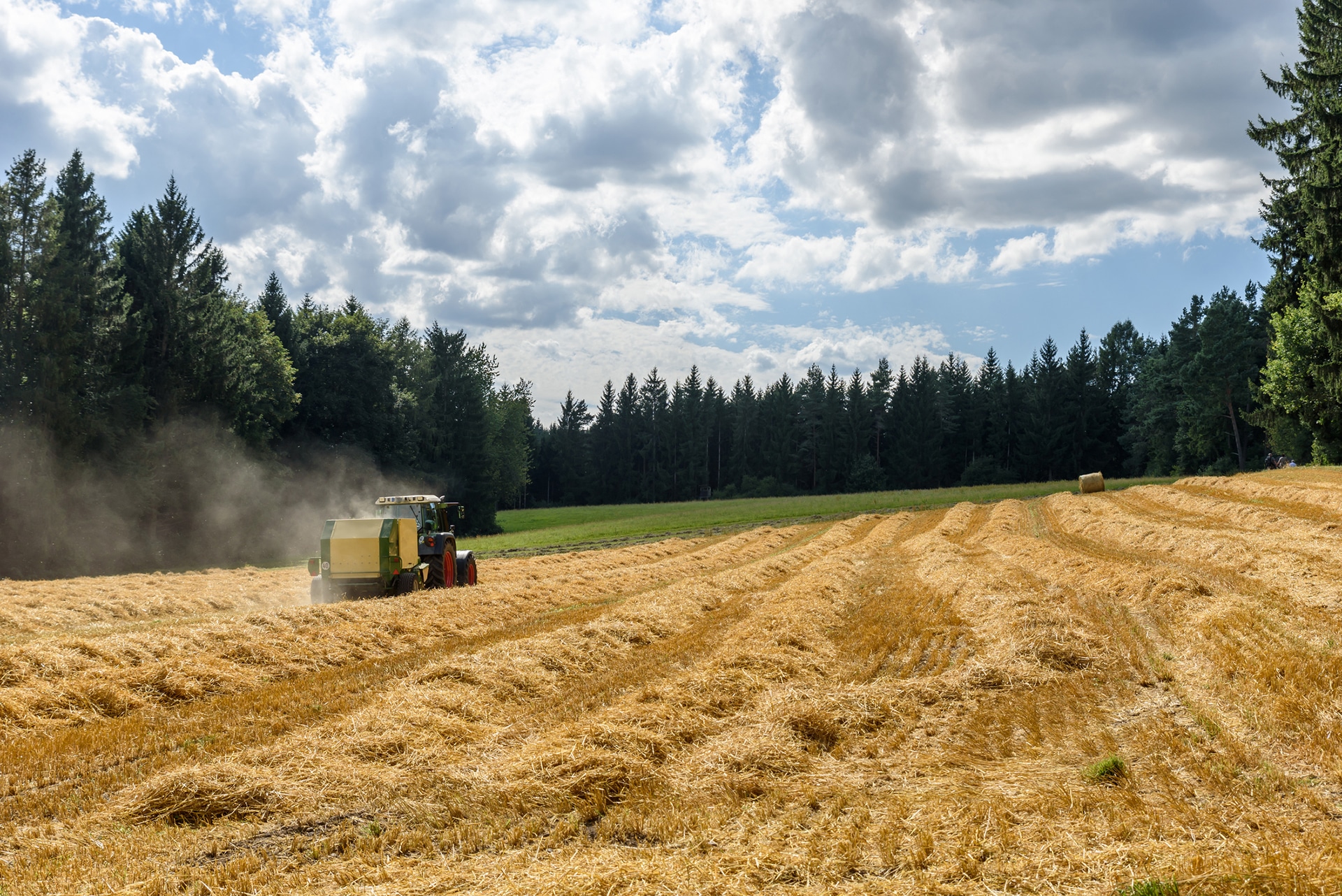
Particulate Matter (PM) aka Particle Pollution
Particulate matter (also called particle pollution or PM) is a term for the mixture of solid particles and liquid droplets (aerosols) in the air. The PM emitted from farms is highly complex, not only in size and physical properties but composition as well. (41)
Here’s how PM works. Particulate Matter is measured and reported as coarse, PM10 (a visible particle between 10 and 2.5 microns in diameter) or fine, PM2.5 (particles 2.5 microns or less in diameter). Particles directly from a source are called “primary particles.” For example, the dust during feed handling or from poultry barns. In contrast, particles created through chemical reactions — ammonia emissions from farms that interact with nitrogen oxide from combustion emissions, for example — are called “secondary particles.” (42)
These particulates are significant because they can penetrate deep into the lungs, causing respiratory diseases in humans; an estimated 3.3 million people die each year globally from exposure. (43) Fine particulate matter (PM2.5) also contribute to haze pollution. Haze has reduced natural visibility from 90 miles down to between 15 and 25 miles in the Eastern half of the United States and from 140 miles down to between 35 and 90 miles in the Western half. (44)
Animal Agriculture & Greenhouse Gasses (GHG)
Oil, natural gas, and coal are substantial sources of human-caused emissions of carbon dioxide (CO2) and other greenhouse gases. But even when combined, their carbon footprint is still lower than that of animal agribusiness.
Animal agribusiness creates the following greenhouse gas (GHG) emissions:
- Carbon Dioxide (CO2) – Largely regarded as the most important greenhouse gas, CO2 has the most direct-warming impact on global climate because of the absolute volume of its emissions. It’s the result of fertilizer for feed crops, on-farm energy needs, feed transport, refrigerated transport of animal products, and land use changes. (45)
- Methane (CH4) – This greenhouse gas is the result of the digestion process (belching, passing gas, etc.) of ruminant animals like cows and from animal manure.
- Methane is 25 – 100 times more destructive than CO2 (21)
- Cows produce 150 billion gallons of Methane per day. (21)
- Methane has a global warming power of 86 times that of Carbon Dioxide. (21)
- Nitrous Oxide (N2O) – This greenhouse gas is 296 times the global warming potential of CO2 and can stay in the atmosphere for 150 years. (21) It’s the result of the fertilizers used to grow animal feed and animal waste like urine and manure. Livestock is responsible for 75% of the global emissions of nitrous oxide. (46)
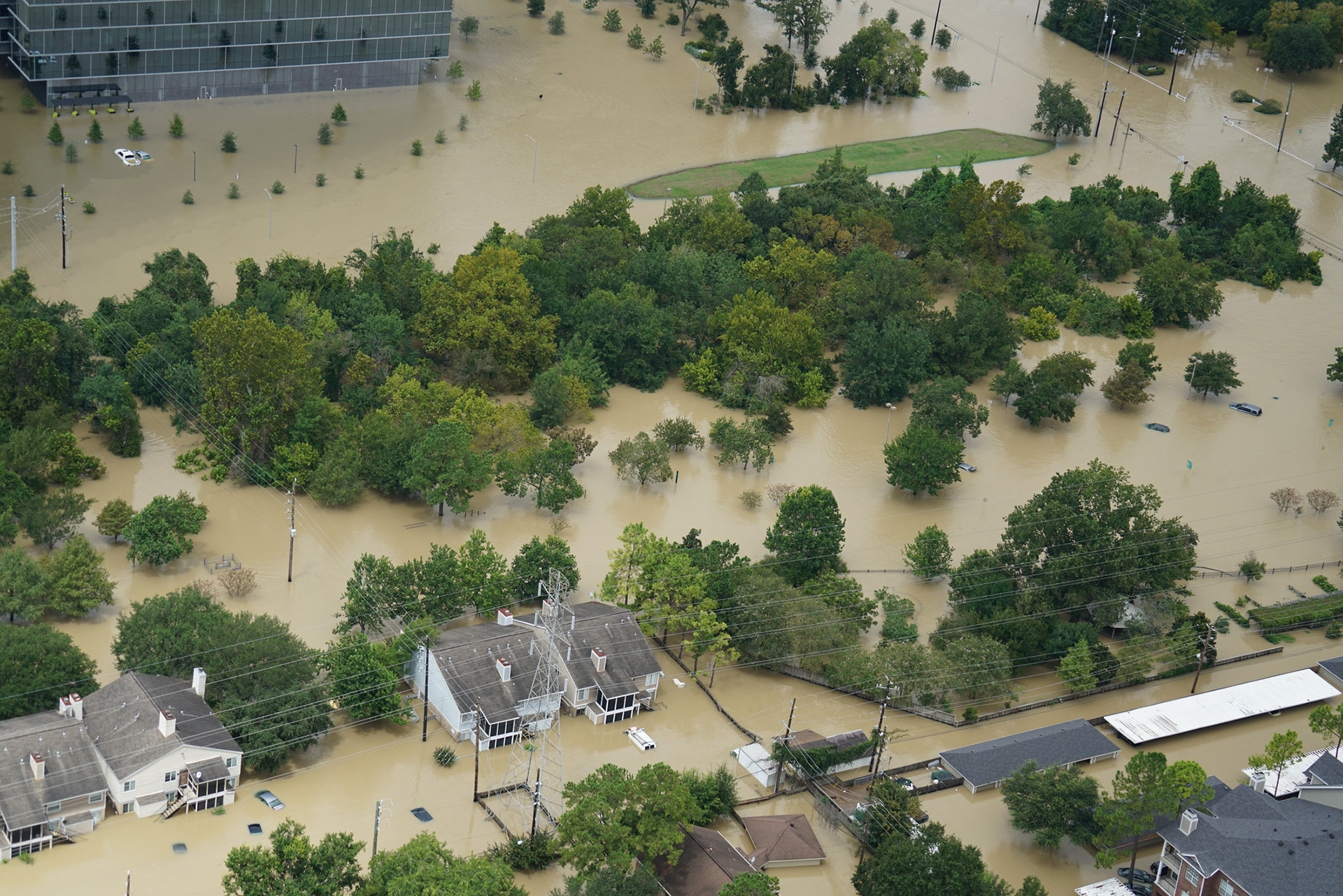
Emissions Impact by the Numbers
The research on agricultural greenhouse gas (GHG) emissions doesn’t always agree on what specific percentage of emissions are the result of animal agriculture.
Livestock’s Long Shadow, a widely-cited 2006 report by UN Food and Agriculture Organizations (FAO), estimates that 18% of annual worldwide GHG emissions are attributable to animal agribusiness. (47) But Worldwatch Institute observes this percentage is too low. They assert raising animals for food is underestimated as a source of GHG, saying, “Our analysis shows that livestock and their byproducts actually account for at least 51% of annual worldwide emissions.” (48)
These aren’t the only two examples; there are more. There are debates as to which percentage by which organization is the most accurate. Studies with lower estimates face criticism for things like leaving out the impacts of deforestation, using longer 100-year time frame in factoring global warming potential and having conflicts of interest with animal agribusiness. Subsequently, studies with higher estimates receive criticism for using livestock respiration in calculating emissions and a lack of peer review. (49)
Researchers may not agree on the percentage, but they do that animal agriculture is a significant source of greenhouse gas (GHG) emissions. It’s important to remember too; climate change is just one of the many negative impacts on the environment as a result of animal agribusiness.
Science & Research
The science and research connecting animal agribusiness and climate change are always growing, but 97% of climate scientists agree: climate-warming trends over the past century are incredibly likely to be the result of human activities. (50) Here are a few articles and academic papers to note for further exploration and additional information:
- 2019 – The production of corn is responsible for 4,300 premature deaths related to air pollution every year. Corn is a key agricultural crop that is used for animal feed which accounts for 36% of all corn produced in the US. Continue to the full article >> Air Quality Related Health Damages of Maize
- 2016 – Transitioning toward more plant-based diets can help mitigate environmental degradation and resource depletion, reduce global mortality by 6 – 10%, and food-related greenhouse gas (GHG) emissions by 29 – 70% Continue to the full article >> Analysis and Valuation of the Health and Climate Co-Benefits of Dietary Change
Further Reading
Section Summary:
Is Climate Change a hoax?
No.
Global Hunger
The connection between world hunger and personal food choices may not seem readily apparent. However, animal-based food productions are directly responsible for many factors affecting hunger, starvation, and even poverty.
All of which cycle back to hunger.
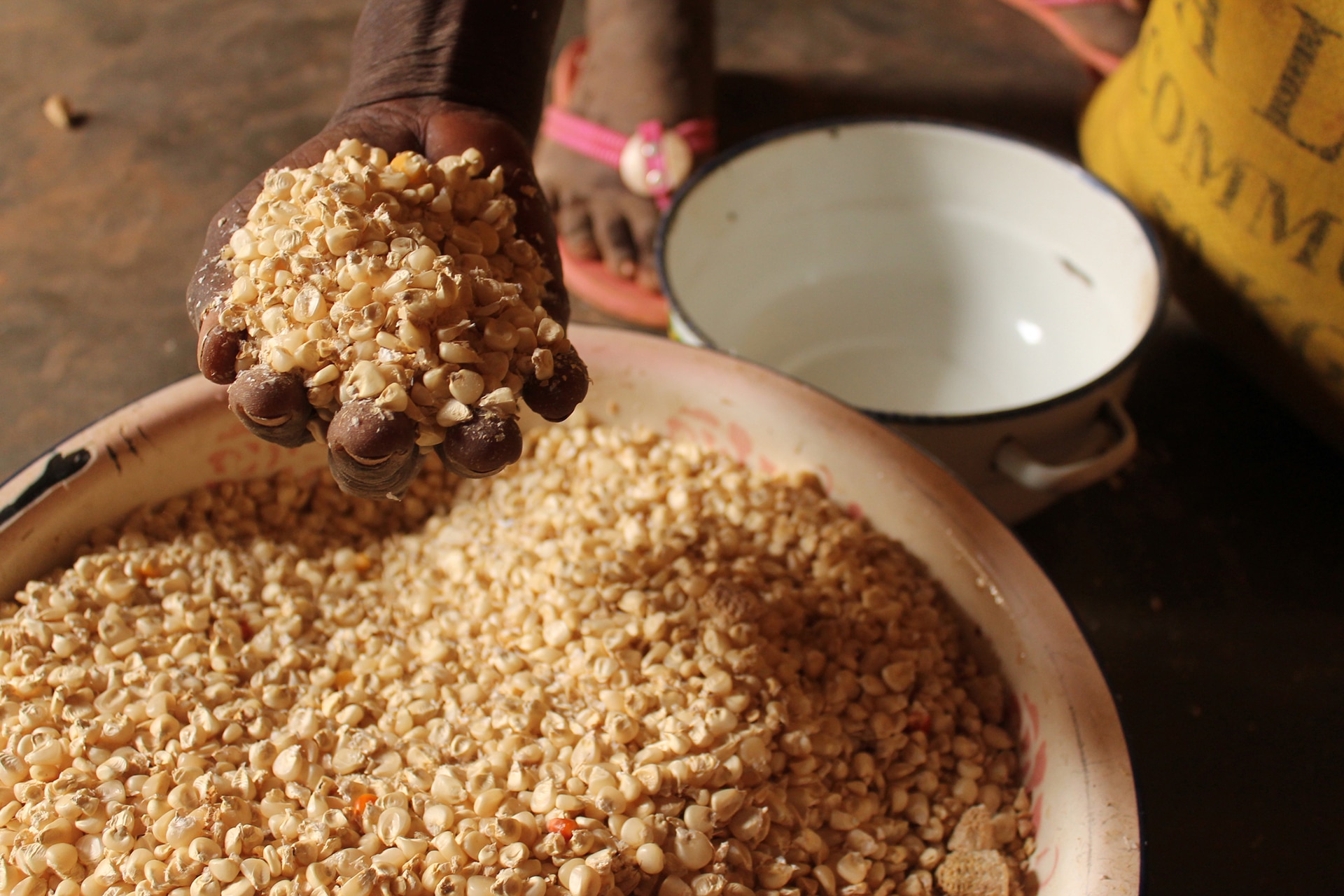
Animal Agribusiness & Global Hunger
Global hunger is on the rise. The number of undernourished people — people facing chronic food deprivation — has increased from 804 million people in 2016 to a staggering 821 million in 2017. (51) That’s one person for every nine.
What causes global hunger? The answer isn’t simple. Hunger is complex; many factors contribute to it, and the reasons are varied and very often interconnected.
Animal agriculture is one of those complex contributors with issues such as:
- It uses an enormous amount of land and natural resources that could otherwise grow food for humans. See also: Resource Depletion
- Feeding most of the world’s edible grain crop to farmed animals is a grossly inefficient use of protein. It imperils impoverished communities where food and natural resources are already scarce, and families cannot afford to feed and provide water to farm animals.
- It’s the ultimate form of food waste. Animal agriculture is responsible for the most losses of all harvested crops on Earth. (52) The reason is that the foods fed animals become energy for them, so those calories don’t end up in human stomachs. Researchers refer to this as the “opportunity food loss.” (53)
- Food insecurity affects farm workers too, from the laborers that grow and pick produce to the ones who work on farms and even in slaughterhouses. Despite the pivotal, necessary role these people play in the stability of our food system, many of them work in unsafe conditions every day in exchange for a salary far below the national poverty level. Often, the workers cannot afford the very food they help produce. (54)
Finally, and perhaps most egregiously, we already produce enough food to feed every human on the planet.
Ending Global Hunger with Veganism
Right now we grow enough food to feed not just the current human population but the whopping 9.7 billion people that are expected to live on the planet in 30 years without changing current crop yields. (55) Here’s the catch, it would require the world to go vegan.
Overall, industrialised meat and dairy production, which currently relies on feeding 34% of human-edible crop calories to animals globally, is highly inefficient in terms of the provision of human nutrition.
In a nutshell, if farmers took all of the lands currently used to raise animals for food and instead used it to grow “nutritionally equivalent combination of plant foods” — foods that provide the same calories, protein, fiber, vitamins and minerals without increasing fat or cholesterol, like potatoes, peanuts, and soybeans for example — we could feed twice as many people as we do now.
There isn’t just one study that concluded a vegan world could wipe out hunger either; there are many more.
Science & Research
The science and research on the ways animal agribusiness contributes to global food insecurity and hunger is always growing. Here are a few articles and academic papers to note for further exploration and additional information:
- 2018– National Academy of Sciences: If farmers took all the land currently being used to raise animals for food and used it to grow plant foods instead, we could sustain more than twice as many hungry now. Continue to the full article >> The Opportunity Costs of Animal-Based Diets Exceeds All Food Losses
- 2016 – Scotland Rural College: “But neither overconsumption nor consumer waste are the largest way we waste the resources that can be used to produce food. That turns out to be livestock production…Livestock are an extremely inefficient way of transforming crops (which they use as feed) into food for humans, with loss rates ranging from 82% (in terms of protein) up to 94% (by dry weight) once all of the feed they consume during their lifespans is considered. It’s not food that goes into our garbage or landfills, but it represents an enormous loss to the potential global supply of food for people just the same.” Continue to the full article >> Human Appropriation of Land for Food: The Role of Diet
- 2015 – Reuters: UN officials believe a vegan shift could alleviate human starvation. “Today half the world’s agricultural land is used for livestock farming, … which is far less efficient for feeding people—and worse for the environment—than producing grain, fruit and vegetables for direct human consumption.” Continue to full article >> Kale or Steak? Change in Diet Key to UN Plan to End Hunger by 2030
Further Reading
Section Summary:
Could veganism help end world hunger?
There is an overwhelming amount of research that says yes. We already produce enough food to feed every human on the planet, but it requires a vegan shift in diets. If we redirected the resources and feed used to raise animals for food and used it to grow plant foods for humans instead, we could eliminate global hunger.
What You Can Do
Whether the information provided in this guide is new or something you’ve already known, it can be overwhelming to learn all the different ways we use animals.
Here are ways you can help them.
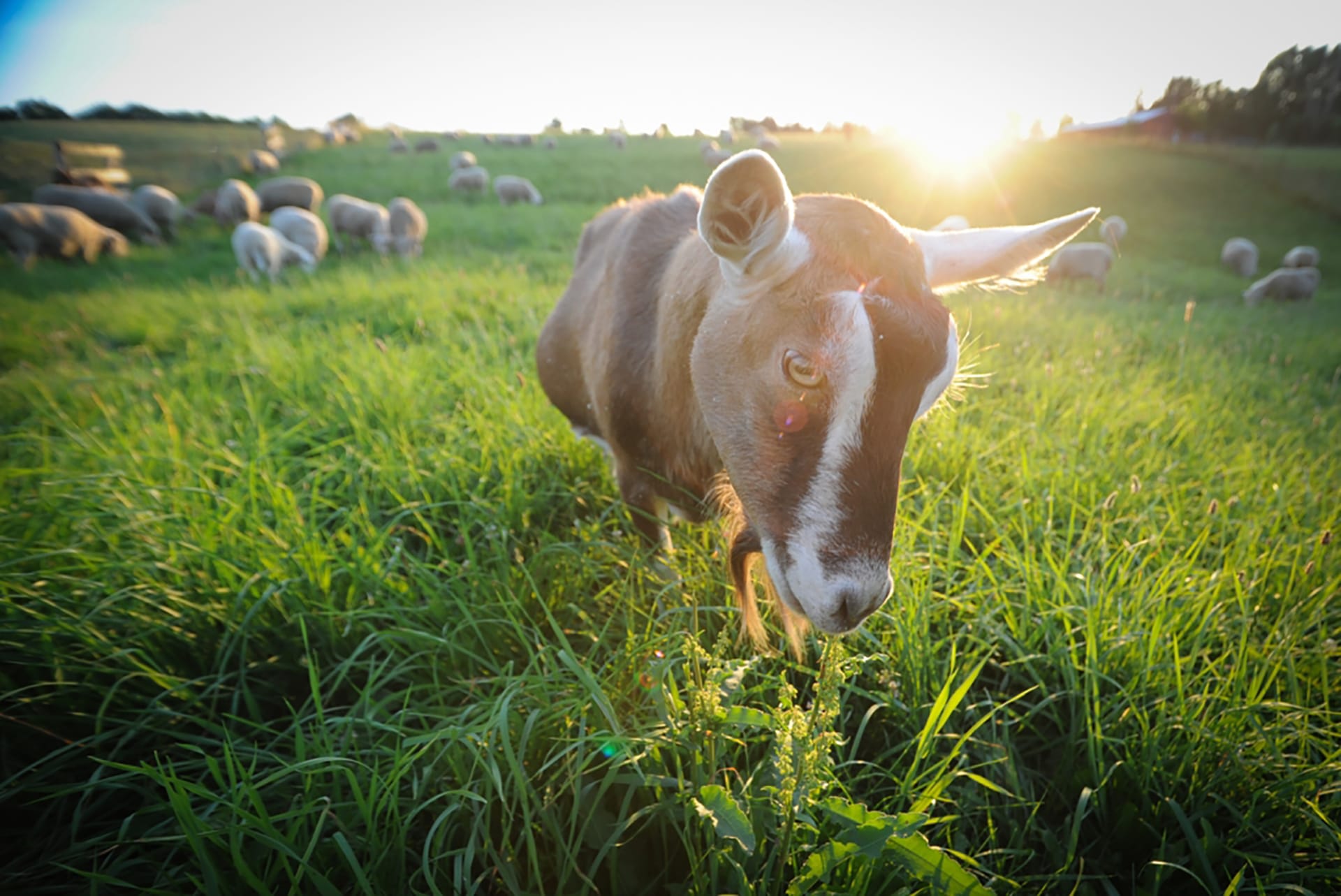
Clarabelle rescued by Farm Sanctuary. New York, USA. (Photo: JoAnne McArthur / weanimals.org)
You Can Change the World
You might be thinking that the whole ‘save the world’ stuff sounds melodramatic, but it’s true. You are the best, and only, defense animals have.
They need you.
Our planet and its inhabitants are in real, serious trouble. Raising animals for food is the single greatest human-caused source of its destruction, literally jeopardizing the future of all people.
Living vegan is the solution.
Humans use animals in millions of ways, some of them are more obvious than others. Removing these animal products from your life isn’t impossible, but it does take some knowledge and practice. Knowledge is power. Power up.
Here are some resources to help you on your vegan journey:
- Do you still need some convincing about why you should live vegan? Visit the Why Vegan guide.
- Have you decided to live vegan but don’t know where to start? Start with this How to Go Vegan guide.
- Here are answers to the top commonly asked vegan nutrition questions.
- Are you ready to start adding plant-based meals to your menu? Here are some vegan recipes to get you started.
- Don’t worry; you get plenty of protein from plants.
- There are plenty of vegan dairy alternatives.
- Have questions about veganism? This extensive library of vegan guides will point you in the right direction.
- Check out this vegan library and bookstore filled with hundreds of vegan-themed books.
- There’s a library for vegan movies too, and a separate Vegan Netflix Streaming Guide.
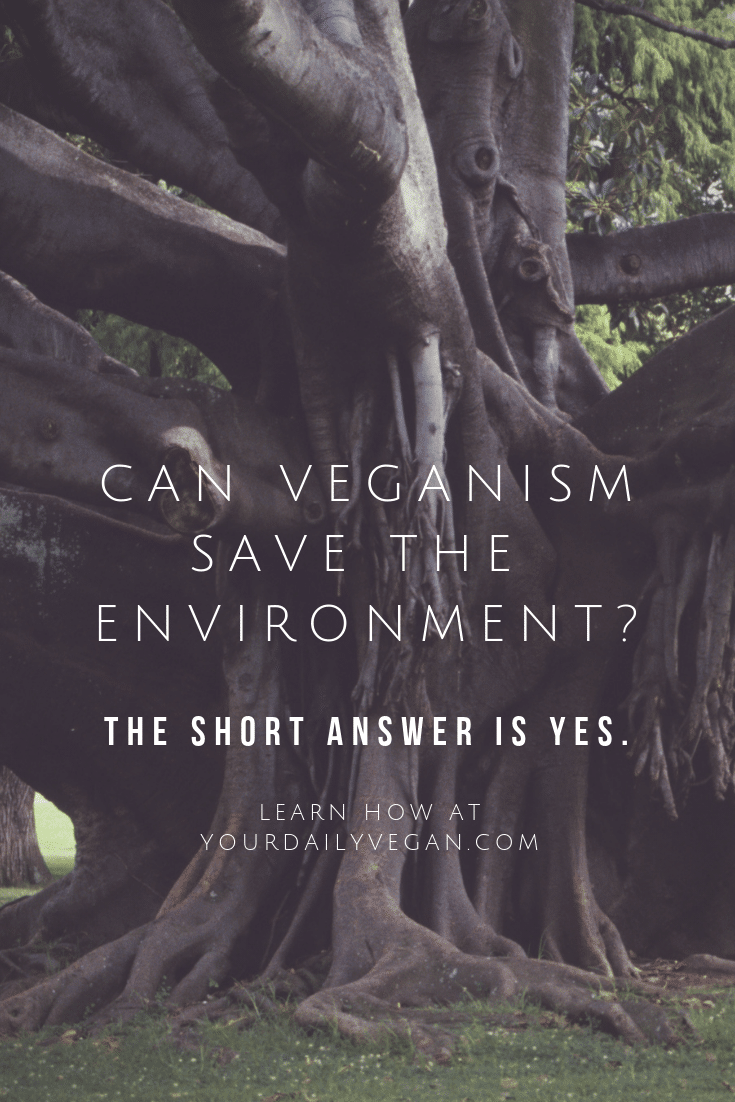
Truth in Advertising
I am committed to providing accurate information to the vegan community. Meticulously researched, the topic explored in this guide contains the knowledge available at the time of publishing. Reviews and updates happen when new material becomes available.
Please contact me if you find incorrect data.

